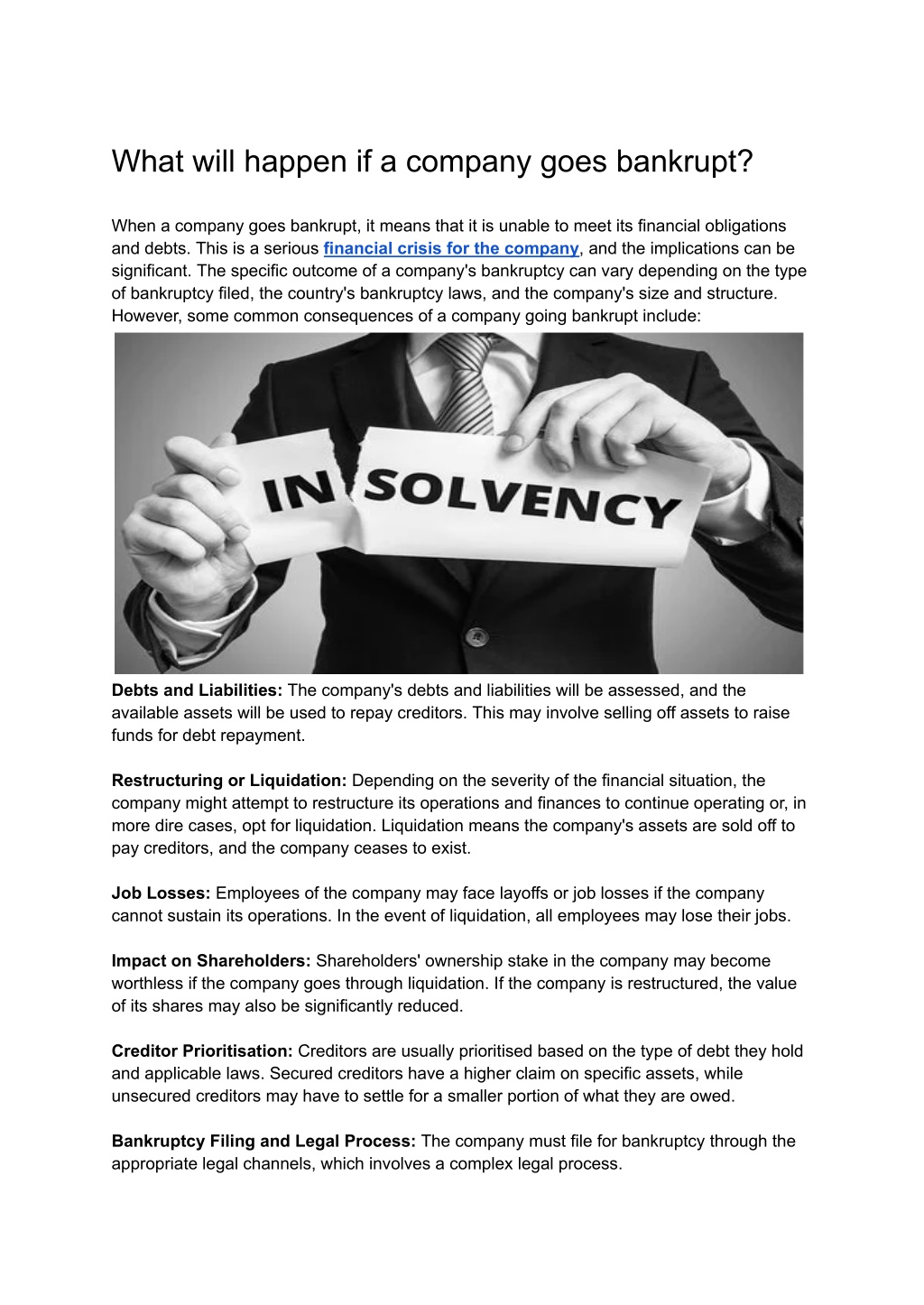Do Employees Get Paid When Company Goes Into Liquidation? Crucial Details for Administration Staff
Do Employees Get Paid When Company Goes Into Liquidation? Crucial Details for Administration Staff
Blog Article
Business Insolvency Company
7 Preswich Avenue, Leigh, WN7 1RZ
0333 567 1686
Recognizing the Repercussions of Company Liquidation on Staff Member Retention and Advantages

Influence On Job Security
In case of company liquidation, the effect on task security can be considerable for workers as unpredictability relating to future work occurs. When a company goes into liquidation, workers deal with the challenging prospect of prospective work loss. This uncertainty can result in enhanced stress and anxiety among the workforce, impacting their spirits and productivity.
Throughout the liquidation process, employees may experience a series of emotions, including fear, frustration, and rage, as they come to grips with the possibility of unemployment. The lack of quality bordering the timeline of the liquidation and the fate of their positions can create a sense of instability within the workforce.
Furthermore, staff members may also be worried about the status of their advantages, such as medical care coverage, retirement, and paid pause, throughout and after the liquidation process. The possible loss of these benefits adds one more layer of intricacy to a currently difficult scenario for employees.
Changes in Employee Benefits

One usual modification is the reduction or removal of particular advantages to cut prices and work out exceptional debts. Employer payments to retirement plans might cease, leaving workers to shoulder the complete responsibility of conserving for their future. Moreover, health care advantages may be downsized, causing higher out-of-pocket costs for clinical services.
Communication comes to be paramount during this duration of transition. Employers need to be transparent about the modifications, giving clear explanations and aid to aid staff members navigate with the alterations. Open dialogue and support can aid reduce stress and anxiety and unpredictability amongst the labor force, fostering a much more positive shift experience regardless of the tough circumstances.
Retention Techniques Post-Liquidation
Following the company liquidation, implementing reliable retention approaches is critical to securing organizational talent and maintaining security within the labor force. In times of uncertainty, employees might really feel anxious about their future work protection and be a lot more inclined to look for alternate employment possibility. To alleviate this danger, companies need to concentrate on open communication, providing openness concerning the firm's circumstance, and providing assistance to workers throughout the transition duration.
One key retention approach post-liquidation is to prioritize staff member wellness and morale. This can be accomplished through normal check-ins, counseling services, and developing a positive workplace. In addition, providing profession advancement opportunities and upskilling programs can boost staff member motivation and interaction throughout tough times. Acknowledging and rewarding workers for their loyalty and commitment can additionally promote a feeling of loyalty and commitment to the company.
Moreover, developing a clear job progression course and establishing reasonable objectives can offer employees a sense of direction and function within the firm (what happens to staff when a company goes into liquidation). By purchasing worker growth and proactively entailing them in decision-making processes, organizations can enhance worker retention prices and develop a resistant labor force post-liquidation
Legal Civil Liberty and Protections
During the consequences of business liquidation, it is necessary to address the legal civil liberties and defenses readily available to employees to guarantee a fair and compliant procedure. Staff members dealing with task loss due to liquidation have actually details civil liberties safeguarded by work regulations. These civil liberties consist of privileges to unsettled salaries, severance pay if applicable, and accrued vacation or authorized leave payments. If needed to navigate the intricacies of the liquidation process., it is essential for employees to recognize these civil liberties and seek lawful suggestions.
In addition, in cases where a firm goes into liquidation, staff members are commonly considered advantageous creditors, providing them higher concern in receiving impressive payments over other financial institutions. This defense helps prioritize resolving worker cases before other monetary commitments are fulfilled. Legal safeguards exist to avoid unjust terminations during liquidation, guaranteeing that discontinuations are lugged out according to developed labor laws. Understanding these legal civil liberties and defenses is fundamental for employees to secure their passions and look for ideal recourse in case of business liquidation.
Dealing With Financial Uncertainty
Navigating financial unpredictability can be a daunting obstacle for staff members affected by business liquidation. The sudden loss of revenue, benefits, and job security can significantly interfere with people' monetary security. Throughout such times, it is important for employees to assess their existing monetary situation genuinely. Producing a detailed spending plan that prioritizes essential expenditures can assist in taking care of instant financial demands. Furthermore, exploring offered government assistance programs, such as unemployment insurance or re-training possibilities, can supply some relief.
Seeking monetary therapy or guidance from experts can offer important understandings into handling financial debts, restructuring financial commitments, and preparing for the future. It is vital for staff members to stay informed regarding their privileges, such as severance plans or exceptional repayments, to guarantee they obtain what they are owed. Thinking about alternative employment choices or job possibilities can help bridge if a company goes into administration do i have to pay them financial spaces during this transitional period. By proactively attending to economic obstacles, staff members can browse through the uncertainty brought on by company liquidation with greater resilience and preparedness.
Verdict
In verdict, company liquidation can have substantial ramifications on employee task safety and security, advantages, and general health. Comprehending lawful rights and defenses can help minimize the impact of liquidation on staff members.
When a company encounters liquidation, the fate of its workers hangs in the balance, elevating important questions regarding work safety and security, advantages, and long-term security. The influence of company liquidation on staff member retention and benefits is a diverse concern that demands a better exam to understand the full extent of its consequences.
Navigating economic uncertainty can be a challenging obstacle for employees affected by company liquidation. By proactively resolving economic obstacles, employees can navigate with the uncertainty triggered by firm liquidation with greater resilience and preparedness.

Report this page